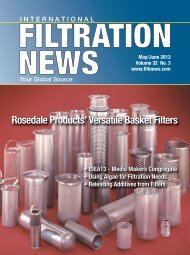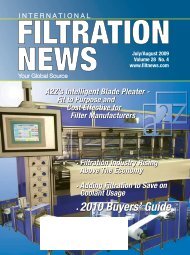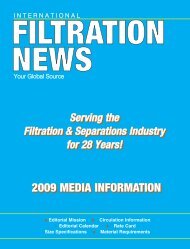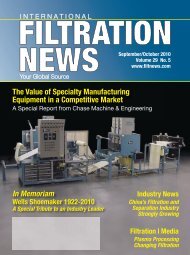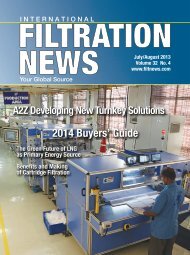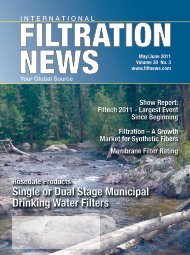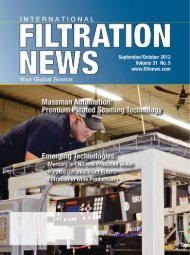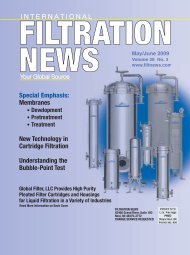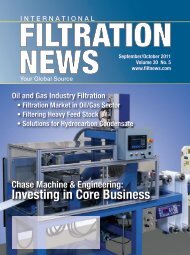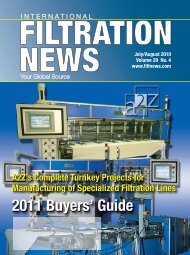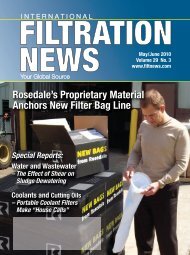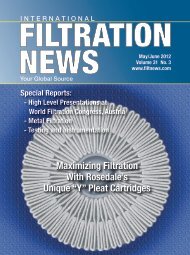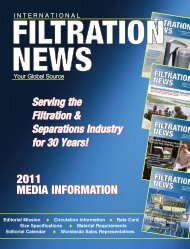Rise of Nonwovens Fosters Innovative Assembly ... - Filtration News
Rise of Nonwovens Fosters Innovative Assembly ... - Filtration News
Rise of Nonwovens Fosters Innovative Assembly ... - Filtration News
You also want an ePaper? Increase the reach of your titles
YUMPU automatically turns print PDFs into web optimized ePapers that Google loves.
I N T E R N A T I O N A LFILTRATIONNEWSSeptember/October 2009Volume 28 No. 5www.filtnews.comYour Global SourceChase Machine & Engineering<strong>Rise</strong> <strong>of</strong> <strong>Nonwovens</strong><strong>Fosters</strong> <strong>Innovative</strong><strong>Assembly</strong> Processes• The “DNA” <strong>of</strong> Your Filterand Filter Media• Frontiers in Membrane Fouling
Introducing SpinTek’s Sparklefilter SystemSparkle Hollow Fiber 'Bundle'Sparklefilter is a proprietarydrinking water system withautomatic backflush capability.Hollow fiber membranes are configuredin a unique module that achieveshigh packing density and provides excellentwater quality. This high flux yetcompact drinking water system with innovativeanti-fouling technology uses“outside-in” hollow fiber membranesengineered for durability and burststrength to allow rigorous backflushing.While conventional systems commonlyuse a resilient bladder to provide backflushwater for membrane cleaning,Sparkle uses an innovative dual non-resilientcollapsible chamber (DNC2)called a “floating pressure cup” to generategreater backflush pressure thanfeed pressure. The system achieves thisbecause the “backflush chamber” has alarger surface area than the “filtratechamber” in the floating cup design.When backflush pressure remainsconstant during the entire cleaning cycle,continuous and steady contaminant removalcan be maintained. The module iseasily cleaned as filtered water is sentthrough the fibers in reverse, flushingaway all solids and biological contaminants.The automatic or manual backflushingcapability provides removal <strong>of</strong>all bacteria and bio-solids with virtuallyno water wasted during cleaning.While Sparkle will remove all bacteriaand suspended solids that are verysmall in size, the performance <strong>of</strong> the filteris enhanced by an integral pre-filterfor solids removal, which reduces fouling,simplifying the system and eliminatingadditional plumbing. Inaddition, other filters or absorbers canbe easily added for specific contaminantremoval such as arsenic, chlorine, mercury,etc., depending upon location andfeed water. The system is versatile andprice competitive and can be used effectivelyanywhere in the world: residentialdrinking water, whole housefiltration, small municipal water systemsor as a stand-alone in rural areasand developing countries with no externalpower source.SpinTek <strong>Filtration</strong>, Inc. specializes inengineered solutions for industrial, commercialand oily wastewater applications.The company <strong>of</strong>fers ultrafiltration(UF) tubular membrane modules andsystems and compact rotary membranesystems (ST-II) using stainless steelmembranes for harsh nuclear or wastewaterapplications. The company designsand manufactures solventextraction (SX) media filters and CoMatrix®coalescers for copper, nickel andzinc mining operations and oil field andrefinery applications worldwide.For additional information contact:Patricia Kirk Email: sales@spintek.comWebsite: www.spintek.com
Editorial Advisory BoardEditorial Board ChairmanEdward C. Gregor, ChairmanE.C. Gregor & Assoc. LLCTel: 1 704 442 1940Fax: 1 704 442 1778ecg@egregor.comM&A, <strong>Filtration</strong> MediaHaluk Alper, PresidentMyCelx Technologies Corp.Tel: 770.534.3118Fax: 770.534.3117alper@mycelx.comOil Removal – Water and AirPeter S. Cartwright, PECartwright Consulting Co.cartwrightconsul@cs.comMembranes, RO,UltrafiltrationWu ChenThe Dow Chemical CompanyTel: 1 979 238 9943Fax: 1 979 238 0651Process <strong>Filtration</strong> (liquid/gas)Equipment and MediaPeter R. Johnston, PETel/Fax: 1 919 942 9092ddandp3@aol.comTest proceduresJim JosephJoseph MarketingTel/Fax: 1 757 565 1549josephmarketing@verizon.netCoolant <strong>Filtration</strong>Gerard J. Lynch, PESigma Design Co., LLCTel: 1 973 912 7922Fax: 1 973 912 5244gjlynch@sigmadesign.net<strong>Filtration</strong> Machinery &Product DesignDr. Ernest MayerDuPont Co.Tel: 1 302 368 0021Fax: 1 302 368 1474ernest.mayer@usa.dupont.comGeneral Solid/Liquid Separationsin All AreasRobert W. McilvaineTel: 1 847 272 0010Fax: 1 847 272 9673mcilvaine@mcilvainecompany.comwww.mcilvainecompany.comMkt. Research & Tech. AnalysisHenry Nowicki, Ph.D. MBATel: 1 724 457 6576Fax: 1 724 457 1214hnpacks@aol.comwww.pacslabs.comAbsorbent Testingand TrainingBrandon Ost, CEO<strong>Filtration</strong> GroupHigh Purity Prod. Div.Tel: 1 630 723 2900bost@filtrationgroup.comAir Filters, Pharmaceuticaland Micro-ElectronicDr. Graham RidealWhitehouse Scientific Ltd.Tel: +44 1244 33 26 26Fax: +44 1244 33 50 98rideal@whitehousescientific.comFilter and Media ValidationAndy RosolGlobal <strong>Filtration</strong> Products Mgr.FLSmidth Mineralsandy.rosol@flsmidth.comTel: 1 800 826 6461/1 801 526 2005Precoat/Bodyfeed Filter AidsEdward C. Homon<strong>of</strong>fHomon<strong>of</strong>f & Assoc., LLCTel/Fax: 1 860 774 5949ech@edhomon<strong>of</strong>f.comFibrous Filter Media &Intellectual PropertyTony ShucoskyPall MicroelectronicsTel: 1 410 252-0800Fax: 1 410 252-6027tony_shucosky@pall.comCartridges, Filter Media,MembranesScott P. Yaeger<strong>Filtration</strong> and SeparationTechnology LLCTel/Fax: 219-324-3786Mobile: 805-377-5082spyaeger@msn.comMembranes, New Techn.Wells ShoemakerAdvisory BoardMember EmeritusDr. Bob BaumannAdvisory BoardMember Emeritus4 • October 2009 • www.filtnews.com
<strong>Filtration</strong> | WastewaterMulti-Element, Self-Cleaning StrainersProvide Efficient 24/7 Water TreatmentFor municipal water treatment,it is critical that suspendedsolids are continuously andcost effectively removed from wastewater.For the Lemay TreatmentPlant in St. Louis, Missouri, thismeans utilizing the appropriate automatic,self-cleaning strainer technologyas part <strong>of</strong> its process to removecontaminants and debris from wastewaterbefore returning it to thenearby Mississippi River.Serving a population <strong>of</strong> approximately1.4 million, the MetropolitanSt. Louis Sewer District (MSD) is responsiblefor operating and maintaining9,649 miles <strong>of</strong> sewerscovering 525 square miles in St.Louis. The Lemay plant can ill-affordfrequent process interruptions, costlydowntime and maintenance expenses,as it is the second largest <strong>of</strong>the district’s seven wastewater plantswith a treatment capacity <strong>of</strong> 240 milliongallons per day (MGD).“Our self-cleaning strainers sit<strong>of</strong>f three large 18-inch pipes that feedthe entire process water system forthe plant,” explained Jon Winslow,planner/scheduler for the MetropolitanSt. Louis Sewer District’s LemayTreatment Plant. “It’s critical thatthe strainers remove solids from thewater to protect critical downstreamequipment such as spray bars, spraynozzles, wye strainers and tubes inheat exchangers. If the strainers shutdown, the plant shuts down.”6 • October 2009 • www.filtnews.comHistorically, some wastewaterplants have utilized automatic, selfcleaningsingle basket strainers, butthis design suffers from specificshortcomings. Due to the limitedstraining area <strong>of</strong> the media, automaticstrainers <strong>of</strong> single basket designcan quickly becomeoverwhelmed and clogged, increasingthe pressure differential and initiatingfrequent backwashes. Plantoperators have resorted to resettingthe differential pressure switch to ahigher set point to prolong the operatingcycle between backwashes.However, this only accentuates theproblem by having to pump at ahigher pressure and thereby increasingoperating costs.In addition, because the backwashmechanism <strong>of</strong> the automatic basketdesign comes into close proximity tothe straining media, large, suspendedsolids <strong>of</strong>ten encountered with rawwater can become lodged between themedia and the backwash arm causingstrainer media damage and/or rupture.Due to inherent design limitations,under high differential pressureconditions, the basket <strong>of</strong>ten becomesdeformed, further increasing the riskthat the backwash mechanism willcome into direct contact with themedia and cause damage.“I know <strong>of</strong> other facilities thathave other types <strong>of</strong> strainers, andthrough word <strong>of</strong> mouth we’velearned that there is a lot <strong>of</strong> labor involvedwith them,” said Mr. Winslow.“But our multi-element water strainersfrom R.P. Adams are pretty muchmaintenance free. They just performwell and demand very little attention– it’s what every plant operator expectsin critical process equipment.”Multi-element, automatic selfcleaningstrainers were first intro-
<strong>Filtration</strong> | Wastewaterduced and patented byR.P. Adams in the 1960s,and are now incorporatedin over 10,000 installationsworldwide.These automatic selfcleaningstrainers employa multi-element,cylindrical wedge-wiredesign whose tubular elementsprovide 3-4 timesthe straining surface area<strong>of</strong> a typical automaticsingle basket strainer.“Each tube is relativelysmall, but because<strong>of</strong> the high number <strong>of</strong>them they have thelargest open surface area<strong>of</strong> any strainer,” said TedGast, a chemist and generalmanager at Carl F.Gast Company (St.Louis, MO), a manufacturer’srepresentativefor industrialinstruments andequipment servingcustomers inMissouri and theadjacent fivestatearea.“With the waythese strainersare designed,they can operatein a 2-4 PSIDrange,” explainedMr. Gast. “Theclean differentialpressure is maintaineduntil 75%<strong>of</strong> the openstraining area isplugged. Thenthe differentialpressure beginsto rise until thebackwash setpoint is reachedand the cleaningcycle is initiated.Maintaining a 2PSID pressure8 • October 2009 • www.filtnews.comdrop over most <strong>of</strong> the filtration cyclemeans reduced power consumptionfrom feed pumps, which adds up tosignificant long term savings.”Additionally, the smaller diameter<strong>of</strong> the media used in the multi-tubestrainers at the Lemay plant enablesthe strainer to safely handle differentialpressures in excess <strong>of</strong> 150 PSIG.This ensures failsafe operation,whereas media found in large basketdesigns can lead to collapse and failureunder differential pressures aslow as 35 PSID.Another significant feature <strong>of</strong> thisdesign is in the engineering <strong>of</strong> thebackwash mechanism itself, whichutilizes a tube sheet to separate thestraining media from the mechanism.This prevents the backwash mechanismfrom coming into contact withthe media and damaging the elementscaused by large solids becominglodged between the media andthe backwash arm.In 2008 as part <strong>of</strong> its $3.7 billion,multi-year Capital Improvement andReplacement Plan to expand capacityto 340 MGD, MSD’s Lemay plant installedthree new automatic R.P.Adams multiple-element strainers.“The original multi-element strainersfrom R.P. Adams had been operatingfor at least 23 years,” recalled Mr.Winslow. “In all that time they’veworked well and given us relativelytrouble-free service, so we decided tostick with the same manufacturer anddesign for the upgrade.”“These automatic strainers dowhat they do and they do it well,”added Mr. Winslow. “We get goodservice out <strong>of</strong> them.”The National Association <strong>of</strong> CleanWater Agencies has awarded theLemay plant a Silver Award five timesFNin this millennium.For more information contact:R.P. Adams Company, Inc., P.O. Box 963,Buffalo NY 14240-0963, USATel: 1-716-877-2608 Fax: 1-716-877-9385Email: info@rpadams.comWebsite: www.rpadams.com
Cover Story | Chase Machine & Engineering<strong>Rise</strong> <strong>of</strong> <strong>Nonwovens</strong> <strong>Fosters</strong><strong>Innovative</strong> <strong>Assembly</strong> ProcessesBy Guy Gil, Sales Manager, Chase Machine & EngineeringChase Machine and Engineering’s 3-head ultrasonic ring welder provides customers the ability to attach filter bags to plasticrings without the use <strong>of</strong> needle and thread.The shift from conventionalglass and cellulose filtrationmedia to synthetic nonwovenmeltblown, spunbond, andneedlepunch fabrics has opened thedoor for the introduction <strong>of</strong> new and excitingassembly methods. Technologiessuch as ultrasonics, hot air, band sealing,RF and impulse welding are becomingcommon practices within theindustry. Engineers now select medianot only based on filtration performancecriteria, but also on assembly preference.Needle and threads combined with adhesivesare slowly being phased out –why incorporate another component(and expense) into the final product, especiallywhen there are safer and moreenvironmentally friendly alternatives?SYNTHETIC NONWOVENSChase Machine & Engineeringhave embraced the move from conventionalfiltration media to syntheticnonwovens. Heat sealing technologies,when incorporated into a continuousprocess, can reduce labor andmaintenance expenses since consumablessuch as adhesives or sewingsupplies like needles and thread areno longer required. While it is understoodthat some filter requirementscall for the use <strong>of</strong> cellulose and glassfibers that require adhesives and/or10 • October 2009 • www.filtnews.comsewing, applications that lend themselvesto the use <strong>of</strong> synthetic mediahave generated exciting new assemblyalternatives.Ultrasonics is now commonly usedin the synthetic HVAC filtration market.Chase Machine was instrumentalin this transition with the development<strong>of</strong> the extended HVAC pocketfilter machine, which was designed,built, and patented incorporating ultrasonictechnology into the continuousassembly process. <strong>Nonwovens</strong>manufacturers realized the importance<strong>of</strong> designing media for use withultrasonics. In the early years <strong>of</strong> development,consistency and unifor-
HVAC Pocket Filter manufactured onChase Machine’s Ultrasonic PocketFilter Machinemity across wide meltblown andspunbond lines was a challenge. Thefinished product, while suitable forthe filtration application, varied in itsdistribution <strong>of</strong> fiber. Although thisnever became an issue when sewing,ultrasonic welding required greateruniformity and consistency.SEPARATE LABIn response to this need, Chase Machineestablished a Materials ApplicationsLab, which enables companies totest materials and assembly methodsbefore committing to full production.Working with some <strong>of</strong> the largest filtrationmedia manufacturers in theworld, Chase Machine have run thousands<strong>of</strong> feet <strong>of</strong> media to verify processimprovements. Many <strong>of</strong> these improvementshave gone on to benefitthe marketplace.The liquid filter bag market presentsan excellent example <strong>of</strong> multipletechnologies combining within theChase Machine’s Materials ApplicationsLab allows customers to testmaterials and assembly methods.same process to improve manufacturingperformance. Employing hot airwelding, Chase Machine joined thetwo edges <strong>of</strong> a needlepunch fabric tocreate a tube on a continuous basis.At the same time, the company integratedultrasonics to cut and seal thebottom <strong>of</strong> the filter, freeing the endproduct <strong>of</strong> loose fibers and contaminants.The process gave the end usercomplete control while cutting laborexpenses by more than 50% and eliminatingthe need for ancillary consumables.What’s more, the finishedbag could be joined to a plastic ringusing ultrasonic plunge welders andeliminating the conventional sewingmethod for attachment.In the membrane market, nonwovensare chosen for their strength as abacker substrate. The synthetic component<strong>of</strong> the nonwovens affords theend user the ability to splice membranestogether or even attach multiplelayers to improve filtrationLiquid <strong>Filtration</strong> Bag Machine combineshot air and ultrasonic technologyto create tubes as well as seal-and-cutneedlepunch or spunbond/meltblownfilter media.characteristics. Ultrasonics, impulsewelding, or even simple bar sealingtechnologies may be incorporatedinto a process line. Chase Machine’sexperience with membrane castingand hollow fiber process lines helpscustomers decide which technologysuits their specific application best.Then they substantiate their conclusionsin the Chase Materials ApplicationsLab.CONCLUSIONToday’s filtration industry is constantlyevolving. Ongoing improvementsto chemistry and manufacturingprocesses <strong>of</strong>fer infinite possibilities fornew product development. By partneringwith companies like Chase Machine,which <strong>of</strong>fers testing, prototypingand full-scale process solutions, thetransition from concept to final productis faster now than ever before.FNFor more information contact:Chase Machine & Engineering, Inc.324 Washington StreetWest Warwick, RI 02893Tel: 401 821 8879Fax: 401 823 5543Website: www.chasemachine.comwww.filtnews.com • October 2009 • 11
<strong>Filtration</strong> | Selecting Filter, MediaThe “DNA” <strong>of</strong> Your Filter and Filter MediaBy Gerard J. Lynch, P.E. and Matthew Borsinger, IFTS Inc. USAWhen used in solid-liquidand liquid-, liquid separationapplications filtersserve a critical function to ensureprocess quality and repeatability.Whether removing particulates that candamage equipment or removing waterfrom fuel to extend system service life,improper filter design and selection canresult in catastrophic failure.Figure 1: Before and after a collapse testThe concept that filters have a specific“DNA” may seem odd but just asDeoxyribonucleic Acid (“DNA”) definesthe nature <strong>of</strong> the human body, there is a“DNA” associated with a filter that defineshow it will perform. Filters areused to separate many different particlesand liquids. The effectiveness and efficiency<strong>of</strong> filters can be determined bylaboratory testing before expensive plantmodifications are made for real worlduse. For instance, most filters and filtermedia have an “unloading point” that isa measureable differential pressure atwhich filters release trapped contaminantsdownstream. The correct testingcan find these “unloading points”. Thesereleased downstream particulates canerode or ruin an engine, cause scrap infood and beverage processing, or mayeven seize mechanical system components.Even an area before the burstpoint where the particulates downstream increase, due to change in pressureor other external conditions, canstill destroy the system. Each filter hasits own attributes and to determinethem you need to consider multiple teststo define the “DNA” <strong>of</strong> a filter.The testing to determine the “DNA”<strong>of</strong> a filter is much more inclusive thansimple initial efficiency, mean poreflow or bubble point testing techniques.While these provide a goodstarting point, “DNA” testing is moreholistic than the above-mentionedtests that provide only one small detailabout the filter. The idea <strong>of</strong> knowingmore about a filter is essential in determiningwhere the filter would performthe best and where it will performthe worst. “DNA” tests using internationalstandards provide results thatare repeatable and allow “apple toapple” comparison with other filtersand their applications.The “DNA” <strong>of</strong> a filter is formed fromthe results <strong>of</strong> various tests depending onthe process application.The tests that help form the “DNA” <strong>of</strong>the filter include:• Burst or Collapse Point Test• Initial Differential Pressure Test• Efficiency Over Time Test• Dirt Holding Capacity Test• Porosity Test• Wettability and Contact Angle Test• Bubble Point and FabricationIntegrity Test• Roughness Test• Mean Pore Flow Test• Water Separation Efficiency TestWith the results <strong>of</strong> these tests the characteristics<strong>of</strong> the filter will come to light.12 • October 2009 • www.filtnews.comCONTRIBUTING FACTORSBurst or Collapse Point (ASTMD3786, ISO 4020, ISO 2941, SAE J80)Filters maintain the cleanliness <strong>of</strong>fluid in a fluid power system by removinginsoluble contaminants. A filter elementis the porous device that performsthe actual process <strong>of</strong> filtration.The capability <strong>of</strong> the filter elementto maintain a specified fluid cleanlinesslevel depends on its performance andstructural integrity, and its ability towithstand non-steady-state conditions(e.g., cold starts and decompressionsurges). The filter element’s resistanceto collapse or burst is a measure <strong>of</strong> itsability to withstand such effects.The burst or collapse point test usesa device that injects fluid into the systemeither continuously or intermittently(sometimes known as “batchloading”). The fluid has a controlledamount <strong>of</strong> test contaminant that doesnot exceed 5 % <strong>of</strong> the element’s estimatedcontaminant capacity, at intervals<strong>of</strong> at least 2 minutes, whilemaintaining the specified test flow rateand test temperature. The contaminantused is injected in a uniform mannerand at low enough concentration sothat the pressure measurement equipmentcan detect any structural failure.Flow rate and differential pressureare measured across the filter as a function<strong>of</strong> contaminant mass added (bymass or time) until the differential pressureacross the element (filter assemblydifferential pressure minus housing differentialpressure) meets or exceeds thespecified collapse or burst pressure ratingor until failure.The filter element collapse or burstpressure rating is verified if:a) There is no visual evidence <strong>of</strong> failurein the element’s structure, filter
medium and seals, when tested, i.e. asdescribed in ISO 2942b) There is no abrupt decrease in theslope <strong>of</strong> the differential pressure versuscontaminant mass added curve prior tothe specified collapse/burst pressurerating.Initial Differential PressureThis test deals with a simple differentialpressure across the filter as thesystem is running. This test does notgive much information about the filter’sperformance over time but is a standardtest, which can give information usefulin designing a system. The Initial DifferentialPressure test defines a baselineagainst which to gauge other tests andapplications.Efficiency Over TimeThe efficiency over time test tells youhow well the filter removes particulatesover a set period <strong>of</strong> time. This test is usuallydone with a continuous or batchamount <strong>of</strong> particulate added to the streamat even intervals and a particle counterdownstream to determine how many particulatesmake itthrough the filter.PorosityPorosity tellshow many holesare in a filtermedia sheet. Thistest can tell youhow much voidarea there is on asingle sheet <strong>of</strong> afilter media. Thisis a standard testfor all filters.Figure 2: Abrupt decrease in the slope <strong>of</strong> the differential pressurevs. contaminant mass added curve indicated contaminant releaseand possible structural failureWettabilityThe wettability <strong>of</strong> a filter determineshow the filter interacts with the liquid.Wetting is the ability <strong>of</strong> a filter to reducethe surface tension <strong>of</strong> the liquid withwhich it is in contact. This informationwill make it easier to understand thedifferential pressures and how the filterinteracts with specific liquids.Bubble Point, Fabrication Ingtegrity Test(ASTM F316, ISO 2942, ISO 4020,JIS K 3832, SAE ARP 901)The International Standard specifiesthat a bubble-point test method is acceptableto measure for filter elementsused in fluid power systems. It can beused either to verify the fabrication integrity<strong>of</strong> a filter element (by checkingthe absence <strong>of</strong> bubbles) or permit thelocalization <strong>of</strong> the largest pore <strong>of</strong> the filtermedium by determining the firstbubble point. The pressure at whichthe first bubble point occurs at is re-www.filtnews.com • October 2009 • 13
<strong>Filtration</strong> | Selecting Filter, MediaFigure 3: Typical bubble-point testing apparatuslated to the largest pore size. It, therefore,defines the acceptability <strong>of</strong> the filterelements for further use or testing.This test is best performed undercontrolled conditions in a laboratory toensure that it is done correctly. The resultsalso have little to no meaning ifthey are not done by a certified lab becausethe standards are specific to aprocess that is done with many checksand balances. Extra air bubbles thatcome from the pipes or just a valve thatis not sealed well can ruin thistest. Results need to be certifiedby a registered and accreditedlab in order to insure the methodsused comply with industrystandards.RoughnessA measurement <strong>of</strong> the filtermedia surface roughness is usedto determine how the liquidwill run over the surface <strong>of</strong> thefilter media. The roughness cantell you more about how the differentialpressure will change due to frictionalforces and also the efficiencybecause <strong>of</strong> the ability <strong>of</strong> the filter tocatch particles.PermeabilityThe permeability test determines theability <strong>of</strong> a liquid to move through a filter.The test will determine how well the liquidmoves through the filter and in whattime period it is able to move through thefilter under constant conditions.Water Separation Efficiency Test(ISO 16332, SAE J 1488..)Modern fuel injection systems, installedin passenger cars as well as inheavy duty or <strong>of</strong>f-road vehicle applications,require high and stable separationefficiencies for all insolublecontaminants in the fuel to ensure aprolonged service life. Beside solid contamination,undissolved water, in finelyor coarsely emulsified form, can also reducethe lifetime <strong>of</strong> injection systems.Suitable fuel filters, having a high level<strong>of</strong> water separation efficiency, are an absolutenecessity for system longevity,especially with Bio-fuels.Factors found to affect the separationefficiency <strong>of</strong> undissolved water inthe field include:• The fuel quality, which is stronglyinfluenced by the performance <strong>of</strong>additives in the fuel itself14 • October 2009 • www.filtnews.com
into accountin the testmethod inorder to reducetheir influenceonthe test results.The optimaldropletsize has to bedeterminedby testingusing properFigure 4: Diameter <strong>of</strong> emulsification devicemeasuringsensors. Inthe ISO standard different orificeplates/sizes are used to produce consistentwater test droplets.• The actual characteristics <strong>of</strong> thefuel/water-emulsion• The specific flow rate <strong>of</strong> thesystem• The type <strong>of</strong> media in the filterelement• The size and design <strong>of</strong> the filterhousing itselfDifferent fuels and additives can beused to test the filter. To ensure laboratorytest results are comparable, thesevarious parameters have to be takenCONCLUSIONSOnly a few tests have been summarizedabove and there are many morethat can provide essential informationabout a filter or filter media. There arealso tests that are specific to the industry,application and fluid in whichthe filter will be used. Knowing the“DNA” <strong>of</strong> a filter helps you determineall areas that will affect filter performancein the intended application. Aclient with a filter media who doesn’tknow the best environment will benefitfrom filter testing and this can helpdetermine possible target applications.The laboratory tests performed on filtershave excellent reproducibility andcan be used to compare and benchmarkfilter performance anywhere inthe world.FNGerard J. Lynch, P.E. and Matthew Borsingerare with International Filter Testing ServicesInc., (IFTS Inc. USA) in Springfield, New Jersey.Jerry Lynch serves as President andMatt Borsinger as a Chemical Engineering intern.IFTS is an independently regulated laboratoryand research center for liquidfiltration and separation science. IFTS has locationsin Europe, USA and China, providingfiltration testing and research services tomany industries. The management at IFTShas compiled a world class team <strong>of</strong> scientists,engineers and technicians in the field <strong>of</strong>Solid-Liquid Separation. IFTS provides aglobal resource for pr<strong>of</strong>essionals working inSolid-Liquid Separation (SLS).Back Your Filters BetterExtensive Range <strong>of</strong> Expanded Metals & Polymers Perfect for membrane support & backing Assures media integrity & pleatspacing even under dynamic flow Materials laminate for co-expansion/contraction/flex Openings down to25 micron Thickness: 0.001”to 0.2”Dexmet Engineerswelcome the challenge<strong>of</strong> your unique materialsand applicationsCustom-ExpandedMaterials from203 294 4440 www.dexmetfilter.comwww.filtnews.com • October 2009 • 15
<strong>Filtration</strong> | Metalworking CoolantTechniques to Add <strong>Filtration</strong> to SaveMoney on Metalworking Coolant UsageBy James J. Joseph, JOSEPH MARKETING, Williamsburg, VAThis article is the second <strong>of</strong>three parts <strong>of</strong>fering ideas onhow to add filtration systemsto existing coolant reservoirs withoutinvesting large sums <strong>of</strong> money and saveon the costs <strong>of</strong> coolant disposal. Thethree techniques are install:1. A sidearm coolant cleaning deviceto an existing reservoir with no filtration.(Published in the July/ August2009 issue)2. A coolant “polishing” device toimprove the clarity <strong>of</strong> an existing filtrationsystem.3. An <strong>of</strong>f-line coolant recovery systemfor batches removed from individualmachines.During difficult economic times each<strong>of</strong> these techniques are possible with aminimum investment and the potential<strong>of</strong> a “quicker” payback from the moneysaved by reducing the number <strong>of</strong>coolant dumps and disposal. This secondapproach does not have the reduction<strong>of</strong> dumping as large a factor as inthe first technique (when no filtrationexisted), because the system already hasa cleaning device in place. However, thisconcept is working on the fact that thesystem must be dumped at a frequencywhere a reduction in the number <strong>of</strong>dumps would result in a cost saving. Itsmain goal is to improve the clarity <strong>of</strong> anexisting system without spending largesums <strong>of</strong> money to revamp the whole facility.It suggests that it is possible to usethe funds normally spent for dumpingas a budget to improve the system whichwould reduce the dumping frequency toa point where a net savings is realized.SIDEARM COOLANT POLISHING DEVICESidearm filtration (known as bypassor kidney loop) is when a cleaning deviceworks <strong>of</strong>f a single reservoir to cleanthe fluid and send it back to the samereservoir. Figure 1 shows an addedcleaning unit working <strong>of</strong>f the cleanedliquid reservoir to further clean thecoolant. Although the term filtration isused, the units could be any cleaning16 • October 2009 • www.filtnews.com
mechanism including filters, centrifuges,magnetic separators or retentiontanks. However, most <strong>of</strong> the timefilters are used as polishing units becausethey have a greater flexibility tointercept material migrating throughthe primary cleaning device.DETERMINE THE BUDGET RANGEThe premise <strong>of</strong> this approach is to seeif the money spent for dumping and disposing<strong>of</strong> dirty coolant can be used to installa polishing filter, which wouldimprove the coolants’ clarity and dumpingwould be less frequent. The combinationwould yield a lower annual cost.This is based on the fact that trucking ortreating waste coolants is viable, and incompliance with the environmental laws.If they are not, then the economics takeon a completely different set <strong>of</strong> inputs.There will be advantages in tool life, machinemaintenance and lower scrap, butthese items can only be estimated andusually take too long to quantify. Theserewards will be measurable (and could besignificant) after the polishing filter is inplace. Since the majority <strong>of</strong> the costs arerelated to dumping, disposing and replenishment,efforts to determine theircosts should yield a general idea <strong>of</strong> themoney involved. The calculations can besimple arithmetic for a given system:1. Calculate the volume <strong>of</strong> liquiddumped and disposed in one year.2. Determine the cost <strong>of</strong> disposing <strong>of</strong>each gallon (trucking away,waste treatment).3. The volume <strong>of</strong> disposed fluid by thecost per gallon will give an annual cost.4. Add labor costs for each dump forthe same year if they are significant.5. Add the cost <strong>of</strong> the fluids, which areneeded to replenish the dumpedcoolant.6. The total will be the target for theannual expenditures.operation with a5,000-gallon reservoir,which isdumped every 8weeks, costs about$39,600 per year.The recognizableinputs for a typicalsituation includes:coolant disposalcost <strong>of</strong> $1.00 pergallon, newFigure 1. Added cleaning unit working <strong>of</strong>f the cleaned liquidreservoir to further clean the coolantOf course the quantities <strong>of</strong> fluidshould be large enough to justify someaction. That does not mean the facilityhas to be a large process. It could be arelatively small volume operation,which is dumped <strong>of</strong>ten, possibly inmonthly cycles.For example, a typical metalworkingwww.filtnews.com • October 2009 • 17
<strong>Filtration</strong> | Metalworking CoolantFigure 2. Math model <strong>of</strong> combination primary and polishing filterscoolant concentrate at $8.00 per gallon,and the mixed coolant concentration at4 percent. This does not include somelabor costs, which may be applicable.Even if the money is saved quicklythere usually is not enough cash to revampthe existing system, which wouldextend the life <strong>of</strong> the coolant indefinitely;plus it would take too much time. Therefore,it is more realistic to see if a sidearmpolishing unit could be added to compensatefor the weaknesses <strong>of</strong> the existingunit, and achieve the goal where the combination<strong>of</strong> installing/operating the polishingfilter and the lower number <strong>of</strong>dumps can save money.SIDEARM POLISHING OPTIONSSidearm polishing selections areusually based on the number <strong>of</strong> times,within a given time period, the reservoir’svolume is sent through the cleaningdevice; i.e. 1,000 gallons at a rate<strong>of</strong> 50GPM has a turnover every 20minutes. Then the turnover flow ratecan be converted to a percent <strong>of</strong> theprocess flow. Both criteria play an importantrole in determining thesidearm polishing flow rate. Largetanks may have settling and a lowsidearm polishing flow rate may notinduce enough turbulence to keep theunwanted material suspended.Determining the sidearm flow ratesas a percent <strong>of</strong> process flow rates allowsthe use <strong>of</strong> field data, which is reflectedin the math models <strong>of</strong> systemsas shown in Figure 2. The table showsan installation where 1,000 units <strong>of</strong>contaminant are generated at theprocess. The unit has a full flow filterand a 25 percent flow-polishing filter18 • October 2009 • www.filtnews.com
is added to enhance the performance<strong>of</strong> the total system. The residue <strong>of</strong>contaminants with the polishing filteris remarkably lower that what can beexpected with just the primary unit,52 versus 39.7.The table also reveals that the polishingfilter can function even when productionis down to reduce thecontaminate level even further. The downtime polishing is significant since the abilityto “catch up” may result in dumpingthe fluid just once a year. If the cost to installand operate the 25 percent polishingsystem and the one dump a year is lessthan the previous number <strong>of</strong> dumps, theproject is economically justified.CLEANING DEVICESThe most common devices installedas sidearm systems are:• Flat bed pressure filters withroll media• Cartridge filters with disposableelements• Bag Filters with disposable bags• Centrifuges• Flat bed vacuum filtersOther devices, which could servebut are not as common, include flat bedgravity filters and magnetic separatorsfor ferrous operations.Selection and sizing <strong>of</strong> the devicemust consider the manufacturers guidelinesfor the application or benchmarksestablished with similar installations.In addition, there are other opportunitiesto minimize equipment costs. Anumber <strong>of</strong> reconditioned “used” cleaningdevices are now available at a lowercost. Many filtration suppliers <strong>of</strong>fer leasingand rental programs payable inmonthly increments. It may be possibleto use a transportable sidearm moduleand move it among a number <strong>of</strong> tankson a routine schedule.FOLLOW THROUGHGranted, this method is outlininga different approach for justificationto invest in filtration to save money.This cursory review <strong>of</strong>fers a guide onhow to quickly measure the magnitude<strong>of</strong> the economics. However,once the range <strong>of</strong> economics is established,the need to cover the details isimportant to insure the logic issound. Not all primary cleaners arecreated equal. Some will not qualifyfor any number <strong>of</strong> reasons. Othersmay not necessarily follow the mathmodel, but still be a feasible candidate.The concept should be reviewedby all involved and by outside resourcesif more know-how on filtrationoptions is needed.Here are just a few <strong>of</strong> the fundamentalquestions, which should bewww.filtnews.com • October 2009 • 19asked for follow through.Are the reservoirs dumped for reasonsother than suspended contaminants?Will a reduced dumping volumechange the cost per gallon to treat ortruck away?What turnover rate will be practical?Will available down time allow thepolishing filter to continue to operate? FNJim Joseph is a member <strong>of</strong> the <strong>Filtration</strong><strong>News</strong> Editorial Board. Tel/Fax: 1-757-565-1549Email: josephmarketing@verizon.net
<strong>Filtration</strong> | TestingVacuum and Pressure <strong>Filtration</strong>By Kyle Nowicki, Process Engineer, FLSmidth Minerals<strong>Filtration</strong> equipment appears inmineral processing, power generation,and environmental flowsheets around the world. This articlewill discuss the fundamentals <strong>of</strong> filtrationtesting and how the data is used toselect the type and size <strong>of</strong> filter bestsuited for an application.The two types <strong>of</strong> filtration technologiesthat will be discussed are vacuum20 • October 2009 • www.filtnews.comand pressure filtration. The main differencebetween the technologies is thedriving force applied to initiate filtration.Vacuum filters use a vacuum pump tocreate a pressure differential across a filtercake, while pressure filters force thefeed slurry in a chamber at high pressureto initiate cake formation and de-watering.Another difference is that vacuumfilters operate continuously while pressurefilters operate in a batch process.Pressure filters generally have more successwith difficult filtering materials dueto the higher applied filtering force.SAMPLE CHARACTERIZATIONThe first step when conducting a filtrationtest campaign is sample characterization.The filter feed solidsconcentration and particle size distributionssignificantly affect the filterability <strong>of</strong>the material and will dictate the requiredfilter characteristics. Typically, materialswith higher feed solids concentrationsand coarser particle size distributionshave higher filtration rates, which resultin less required filtration area.Sample characterization allows thetest engineer to predict how the materialwill filter, which will indicate the type <strong>of</strong>equipment to be used. The test campaignshould be developed in a way to simulatefull-scale operation. Initial testingwill indicate the feasibility <strong>of</strong> using a particulartype <strong>of</strong> filter for the application.VACUUM FILTRATIONThe most commonly occurring vacuumfilters are drum, disc, and horizontalbelt filters (HBF). The HBF is themost recently developed filter designand consists <strong>of</strong> a belt supported byrollers on each end. The filter operatesunder the same principles as drum anddisc filters but has a flat, horizontal orientationas opposed to rotary.All vacuum filter cycles consist <strong>of</strong>cake formation and discharge along withone or more <strong>of</strong> the following cycles:
1. Deliquoring/Dewatering2. Washing3. Air Drying4. Steam DryingOnly the de-watering portion <strong>of</strong> thecycle will be described in detail, as theadditional cycles would be too extensivefor treatment in this article.Once the process flow diagram andthe objectives <strong>of</strong> the filtration testing aredetermined, filter leaf tests can begin.There are two types <strong>of</strong> filter leaf arrangementsthat are used to simulate full-scaleequipment. The “top feed” method simulateshorizontal belt filter operation and“bottom feed” for drum and disc filter operation.Both arrangements utilize a filterleaf, a vacuum receiver, a vacuum pump,and a gas meter. The process variables <strong>of</strong>the top feed method are feed slurry volumeand dry time. The variables <strong>of</strong> bottomfeed method are cake formation timeand dry time. The top feed and bottomfeed arrangements are illustrated in Figures1 and 2, respectively.Fig. 1. Top feed leaf test arrangementBefore a full series <strong>of</strong> tests are conducted,the optimum filter media must beselected. This is accomplished by performingleaf tests on various filter mediaunder the same process conditions. Filtermedia construction is based on severaldifferent properties including: material,type <strong>of</strong> finish, weave, air permeability,and particle retention. Media selectionis based on the following observations:1. Cake Formation Timewww.filtnews.com • October 2009 • 21
<strong>Filtration</strong> | Testing2. Filtrate Clarity3. Filter Cake Release4. Media BlindingThe media should exhibit the highestoverall performance <strong>of</strong> the four differentproperties in order to be selectedfor further testing.The objective <strong>of</strong> the leaf testing is todevelop correlation curves that relatecake thickness to dry cake loading, WFig. 2. Bottom feed leaf test arrangement(expressed as lbs/ft2); cake dry solidsweight to cake formation time; andcake moisture to drying time dividedby cake loading or Moisture CorrelationFactor. The information derivedfrom the correlation curves is used todetermine the filtration rate and the requiredfiltration area. Sample correlationcurves are shown in Figures 3 - 5.The process variables <strong>of</strong> the leaf testing(de-watering only) include: formvolume/time, dry time, and vacuumlevel. The form and dry vacuum levelsshould be adjusted with varying altitudeas air pressure will affect the attainablevacuum. Vacuum levels and airflow rates are recorded for sizing thevacuum pump and receiver.The form time, dry time, filtrate volume,cake thickness, and the wetweight <strong>of</strong> the cake are recorded. Thesamples are then dried, weighed andthe solids concentration calculated.The correlation curves are used toselect a cake thickness and final cakemoisture, which yields the total cycletime. The dry cake loading and cycletime are entered into the followingequation to calculate the design filtrationrate (expressed as lb/hr-ft 2 ).<strong>Filtration</strong> Rate = W x 60 x SF/Ø TWhere: W = Dry Cake Loading60 = Time ConversionSF = Safety FactorØ T = Total Cycle Time22 • October 2009 • www.filtnews.com
Fig. 3. Dry Cake Density Fig. 4. Dry Cake Weight Formation Time Fig. 5. Cake Moisture CorrelationA safety factor is incorporated intothe design filtration rate to allow the filterto maintain performance throughslight feed variations. The magnitude <strong>of</strong>the safety factor varies based on filterfeed characteristics. The design filtersolids loading (lb/hr) is divided by thefiltration rate (lb/hr-ft 2 ) to generate therequired filtration area.PRESSURE FILTRATIONAll pressure filter cycles consist <strong>of</strong>cake formation and discharge along withone or more <strong>of</strong> the following cycles:1. Pre-Squeeze2. Washing3. Air Drying4. Final SqueezeAgain, there are two methods usedto simulate the full-scale equipment.The bench test apparatus is a small singlechamber that allows for differentcake thickness and feed pressures, aswell as simulation <strong>of</strong> membrane plateoperation. The filter leaf test arrangementis shown in Figure 6.Filter media selection is also the firststep in a pressure filtration test campaign.The bench test is conducted by pumpingfeed slurry into the double-sided chamber.Filtrate production is measured withrespect to time while the chamber is filling.It is very important that a completelyconsolidated cake is formed during thecake formation step as the final cakemoisture and equipment sizing will be affected.Once the chamber is full thepumping is stopped. The final step is toconduct a cross-flow air blow from oneside <strong>of</strong> the chamber to the other to dewaterthe cake to the desired moisture.The filtrate production is measured withrespect to time as before. In the case <strong>of</strong>the membrane squeeze option, a mechanicalsqueeze is applied to the cakewww.filtnews.com • October 2009 • 23before and after the air dry.Typically, the recessed chamber optionis tested first due to simple filter designand higher available slurry feed
<strong>Filtration</strong> | Testingpressure. Thin cake chambers are testedfirst and depending on the filtrationtime, thicker chambers can be tested. Ifthe target cake moisture is not achievedwith the recessed chamber option andthe filter cake is compressible, the membranesqueeze may provide the sufficientFig. 6. Pressure FilterLeaf Test Arrangementmechanical force to further de-water thefilter cake. The filter arrangement thatachieves the target cake moisture withoptimum cake thickness and cycle timeis selected for full-scale sizing.The required filtration volume is calculatedby dividing the filter solidsloading (lb/hr) by the dry bulk cakedensity (lb/ft3) and by the number <strong>of</strong>cycles per hour, which will yield the requiredfiltration volume per cycle.SUMMARYBench-scale leaf testing is the most effectivemethod to obtain the informationrequired to size full-scale filters. If thetest plan is developed properly and thetests conducted according to standardprocedures, the results are repeatable.A variety <strong>of</strong> industries require filtrationtechnologies that fit a particular application.Having multiple filter types,arrangements, and footprints availableallows customers to select the filter thatbest suits their flow sheet.FNFor more information contact:Kyle Nowicki, FLSmidth Minerals2850 South Decker Lake DriveSalt Lake City, Utah 84119Tel: 1-801-526-2419Email: kyle.nowicki@flsmidth.com24 • October 2009 • www.filtnews.com
The United States Army isusing state-<strong>of</strong>-the-art membranewater purificationtechnology to support highly mobilemilitary operations and humanitarianmissions. The new lightweight waterpurifier (LWP) can be easily transportedto remote locations to producesafe drinking water from almostany available raw water, includinghighly turbid surface water, brackishwater and seawater. The LWP canalso purify water contaminated withnuclear, biological and chemical warfareagents. Mechanical EquipmentCompany, Inc. (MECO), Sugar Land,Texas, designed and manufacturesthe unit for the U.S. military.It takes only four soldiers to carrythe LWP, which is so simple to operatethat a two-person team can assembleit and begin producing waterin just 45 minutes, using water froma river, lake, pond, or ocean. The entiresystem can be transported in thecargo space <strong>of</strong> a Humvee and by asingle haul <strong>of</strong> a medium-lift utility orassault helicopter such as the UH-60Black Hawk.The LWPs have been developed totreat the very high salt concentrationsfound in the Middle East,where water in the Arabian Gulfreaches 45,000 parts per million(ppm) <strong>of</strong> salt, and some dessert waterholes reach 60,000 ppm. Earlier desalinationsystems had been designedfor conventional seawater salt concentrations<strong>of</strong> 35,000 ppm.The compact LWP unit will produce125 gallons per hour (gph) from freshor brackish water and 75 gph from seawater,sufficient to support company/battalion-sizedunits in the field.The exact number <strong>of</strong> people the LWPunit can sustain depends on whether itis being used solely for drinking water,or will be used for cooking, cleaning,showers, or laundry.www.filtnews.com • October 2009 • 25Water | PurificationNew Water Purification TechnologyReports for Duty in the U.S. ArmyEVOLUTION OF TREATMENTWater filtration technology used intransportable water treatment systemshas evolved significantly since its beginningsmore than sixty years ago,when thermal desalination systemswere used by the Marine Corps. in theinvasion <strong>of</strong> Iwo Jima.
Water | PurificationFigure 1: The tangential flow <strong>of</strong> the feed water across the membrane surface mitigatesfouling in the ultrafiltration membranes.The new LWP combines two types <strong>of</strong>membrane filtration: ultrafiltration(UF) for pretreatment, followed by reverseosmosis (RO). UF is a low pressureprocess for separating larger sizesolutes from aqueous solutions using asemi-permeable membrane. RO relieson a pressure differential to force a solution(in this case, water) through amembrane that retains the solute onone side and allows the pure solvent topass to the other side. RO membranesreject dissolved and suspended materials,including monovalent salts. Sinceessentially all dissolved and suspendedmaterial is rejected by the membrane,the RO permeate is pure water.This design replaces the Army’s previousgeneration <strong>of</strong> portable water processingequipment, which pretreated theRO feed water with multi-media filters(MMF) and disposable cartridge filters.The MMF and cartridge filters canonly remove suspended solids betweenapproximately 1-5 microns, allowingsome particulate breakthrough and causingquick fouling <strong>of</strong> the RO membranes.Also, the cartridge filters require frequentreplacement, sometimes every half hour.In addition to the labor involved in replacingthe filters, the continual resupply<strong>of</strong> consumable items can be adangerous logistical challenge in remotelocations and under combat conditions.UF PRETREATMENT OF RO FEED WATERThe UF membrane process eliminatesthe need to replace and resupply disposablefilters. The 5-inch diameter UF cartridgescontain hollow fiber membraneswith an internal diameter <strong>of</strong> 35-milli-inch(mil). The membranes and the cartridge26 • October 2009 • www.filtnews.com
housing are composed <strong>of</strong> polysulfone, ahigh strength polymer thermoplastic withexcellent chemical stability under a widerange <strong>of</strong> temperatures.The UF membrane, a ROMICON®ROMIPURE® UF cartridge from KochMembrane Systems, Inc. (KMS), Wilmington,Massachusetts, USA, consistentlyproduces filtrate water with a tenfold improvementin turbidity over MMF andcartridge filters. The UF membranes removeturbidity, suspended solids, bacteriaand other microorganisms from thefeed water that can foul the downstreamRO membranes. The higher quality filtratewater prolongs RO membrane lifeand dramatically extends the time betweenRO cleanings, regardless <strong>of</strong> the feedwater conditions.In addition to limiting the fouling <strong>of</strong>the RO membranes, the UF membranehas important features that limit its ownfouling. The hollow fiber cartridges operatefrom the inside to the outside duringfiltration (see Figure 1). The feed water(retentate) flows through the center <strong>of</strong> thehollow fiber, and the filtered water (permeate)passes through the fiber wall to theoutside <strong>of</strong> the membrane fiber. The tangentialflow <strong>of</strong> the retentate sweeps acrossthe membrane surface and continuallyacts to limit membrane fouling.The UF hollow fiber cartridge’s structuralintegrity and construction enables itto withstand permeate back flushing andthe reversing <strong>of</strong> retentate flow, cleaningprocesses that are highly effective inrestoring flux rates. Its hollow fiber geometryallows for a large amount <strong>of</strong> membranesurface area in a compact moduleand this high packing density means largevolumes <strong>of</strong> water can be filtered usingminimal space and power, both <strong>of</strong> whichare critical advantages.A high-pressure pump driven by adiesel engine draws water from a 40-gallonfiltrate tank on the UF module andfeeds the RO module under pressures <strong>of</strong>up to 1,200 pounds per square inch (psi)to provide backwash and fast flush capabilitiesfor the UF membrane, while allowingcontinued operation <strong>of</strong> thehigh-pressure pump.RO PRODUCES PURE WATERThe RO module consists <strong>of</strong> sevenFLUID SYSTEMS® TFC®spiral RO elementsmanufactured by KMS. The membraneelements, which are widely usedaboard ships and on drilling rigs, featurea proprietary thin film compositepolyamide designed to increase efficiencyand reduce costs. The pressure vessels areconstructed <strong>of</strong> titanium.The RO membranes remove dissolvedand suspended materials, including organicsand salts. Only molecules in therange <strong>of</strong> 5 angstroms (0.0005 micron)will pass through the membrane. Approximately30 percent <strong>of</strong> the RO feedwater is recovered for use as drinkingwater, and the remaining concentrate (orbrine) is discharged as reject. The ROpermeate is then passed through a chemicalmodule, where it is metered and disinfectedwith chlorine.RELIABLE FILTRATIONAbout half <strong>of</strong> the 380 LWP units orderedby the U.S. Army are in use supportingU.S. Army field troops in Iraqand Afghanistan. For example, the82nd Airborne Division is using a number<strong>of</strong> LWP’s in Iraq to provide water fortheir mobile kitchens. This is safer andmore practical than the older method<strong>of</strong> using bottled water, which requiredwww.filtnews.com • October 2009 • 27
Water | Purificationextensive logistical and security supportto ensure that the water made it tothe remote sites untainted.Prior to field deployment, seven prototypesystems were built and subjectedto rigorous and exhaustive testing by theU.S. Army, including 5,000 hours <strong>of</strong> operatingtime and 1,600 miles <strong>of</strong> crosscountrytransportation testing in the back<strong>of</strong> a Humvee. The design and testingprocess led to important system refinementsand improvements, including designingthe system to sustain severalfreeze-thaw cycles, conditions that gowell beyond the environmental requirements<strong>of</strong> most water purification systems.“The KMS membranes have been remarkablyresistant to fouling,” said JohnKlie, MECO’s Government Business DevelopmentManager. “We worked closelywith KMS engineers to develop and optimizean automated backflushing methodthat has practically eliminated the needfor chemical cleaning operations.”According to Kyaw Moe, the MECOLWP Program Manager who providestraining and technical assistance to theArmy specialists who operate the LWPunits, “I was recently in contact withmembers <strong>of</strong> the 10th Mountain Divisionheadquartered at Camp Liberty,Iraq,” said Mr. Moe. “They have beenusing the LWP in combat conditionsfor over a year, producing clean waterwithout the need for a single chemicalcleaning procedure.”On top <strong>of</strong> simplifying the process,using fewer chemicals means the watertastes better. “The water produced bythe LWP is very palatable,” said Mr. Klie.“The challenge with older conventionalsystems has been over-chlorination,which gives water a ‘swimming pool’taste. The LWP’s automated chlorinedosing system prevents this from occurring,and produces a drinking watertaste very similar to commercially availablebottled water.”AN ECONOMICAL SOLUTIONThe LWP has proven to be a highlyeconomical solution in Iraq, where thecost <strong>of</strong> supplying bottled water to thetroops can be as high as $5 per gallon.Water produced by conventional firstgenerationpurification systems costs approximately$1 per gallon, including thecost <strong>of</strong> disposable filters, chemicals andfuel, while the LWP produces water at 7cents per gallon, primarily the cost <strong>of</strong>diesel fuel to operate the system andchemicals for minimal, periodic cleaning.The LWP provides a self-supportingwater purification method for SpecialForces and other remote military and humanitarianmissions that eliminate theneed for difficult, expensive and dangerouswaterFNresupply.For more information contact: Peter Bouchard,KOCH Membrane Systems, Inc.Tel: 1-978-694-7309 Fax: 1-978-657-5208Email: pabrouchard@kochmembrane.com28 • October 2009 • www.filtnews.com
Koch Membrane Systems, Inc.(KMS) a pioneer in membranetechnology, filtration systems,system design and process expertise fornearly half a century, has been selectedto provide a seawater reverse osmosis(RO) system for Minera Esperanza’scopper-gold mine, at Michilla Port,Chile. The overall project, which wasawarded to Nicolaides S.A., will providedrinking water to the mining camp.Construction <strong>of</strong> the system is expectedto be completed in the fall <strong>of</strong> 2009.“By using a seawater reverse osmosissystem, Minera Esperanza can providea safe and plentiful water supply to itsworkers,” said Sergio Ribeiro, KMS’Commercial Director for South America.“The system has a number <strong>of</strong> featuresthat make it ideal for this site,including its small footprint, lowerKoch Membrane Systems Selectedto Provide Seawater RO Systempower consumption due to an energyrecovery device, high productivity andexcellent permeate quality.”The project consists <strong>of</strong> two MegaMagnum®RO MM2 equipment skidswith a total <strong>of</strong> 20 MegaMagnum seawaterelements. The water supplied to thecopper-gold mine begins with seawaterdrawn from the Pacific Ocean. The seawateris pumped for about a mile to awater treatment unit and then throughthe RO system. The final permeate isdisinfected with chlorine, making it acceptablefor drinking water. The permeateflow rate is 520,000 gallons per day;maximum feed total dissolved solids(TDS) is 45,000 ppm; and the requiredchloride concentration is less than 250ppm in the finished water.MegaMagnum elements are the standardfor large diameter RO projects.Among the many benefits <strong>of</strong> the KMS designare significantly reduced footprint,project costs, and installation time. Sincelarge diameter RO systems use one-sevenththe number <strong>of</strong> elements compared tostandard 8-inch systems, maintenancecosts associated with connections and O-rings are reduced. KMS has made loadingand unloading <strong>of</strong> MegaMagnum elementssafe and easy with the use <strong>of</strong> a hand-operatedwinch. Typically, it takes less timeto empty one pressure vessel containingMegaMagnum elements than the comparablenumber <strong>of</strong> 8-inch pressure vessels.Based in Wilmington, Massachusetts,Koch Membrane Systems, Inc.is a Koch Chemical TechnologyGroup, LLC company, and a globalleader in membrane filtration technologyand engineering support forclose to half a century.FNwww.filtnews.com • October 2009 • 29
Membranes | FoulingFrontiers in Membrane FoulingBy Haluk Alper, President, MyCelx Technologies, Gainesville, GAIt has been estimated that fouling <strong>of</strong>RO membranes has an impact in excess<strong>of</strong> a $1 billion/year. The problemis well known, but the causes areincompletely understood. Some <strong>of</strong> thefactors involved in fouling (colloidal andparticulate matter) have been studied insome detail. The sum <strong>of</strong> what is understoodis not able to account for the observedbehavior <strong>of</strong> membrane units inservice (Paul & Abdul, 1990). Typicalsequence <strong>of</strong> membrane operation is illustratedin Table 1.Why should there be a severe (discontinuous)decline in flux on the firstday? Why should this decline in fluxcontinue in a relatively uniform (continuous)manner until the onset <strong>of</strong> bi<strong>of</strong>ilmformation? This article will discuss twoTable 1. Paul, D. & Abdul, R. (1990). Reverse osmosis: Membrane fouling – the finalfrontier. Ultra Pure Water, 7: 25-36.factors, which may account for some <strong>of</strong>this behavior.30 • October 2009 • www.filtnews.comEXOPOLYSACCHARIDESRecent DNA sequencing <strong>of</strong> oceanwater has revealed the presence <strong>of</strong> anamazing diversity and density <strong>of</strong> microbiallife. Most <strong>of</strong> the characterized specieshave never been seen (very small). Otherwork has shown that membrane decompositionproducts have multiple fates.Most are adsorbed onto sediment, but afraction is solubilized. Cellular membraneshave a number <strong>of</strong> molecular constituents,which have evolved to interactwith and operate at interfaces. Exopolysaccharidesare the most externalconstituent and are involved in cell adhesionto surfaces. This is a viscous, mucousy,highly visco-elastic material thathas both oleophilic and oleophobic componentsand is able to transform its threedimensionalconformation based on thesurface energy <strong>of</strong> the surroundingmedium and on steric factors.Exopolysaccharides can drastically affectthe flow characteristics <strong>of</strong> water overa surface. Production <strong>of</strong> exopolysaccharidesis increased when microbes arestressed. Purification <strong>of</strong> water, as in pretreatmentoperations, is a stressing factorand will result in the microbe trying toprotect itself from adverse osmotic conditionsby production <strong>of</strong> more exopolysaccharide.An example <strong>of</strong> the ability <strong>of</strong>
exopolysaccharides to alter the flow characteristics<strong>of</strong> water over a surface is illustratedby the fact that the US Navy has todry dock destroyers yearly (recently scubadivers are also employed for this purpose)in order to remove 1 lb. <strong>of</strong> brown algaefrom the hydroplane surfaces on the bottom<strong>of</strong> the ship. This material is so viscoelasticthat it decreases the maximumspeed <strong>of</strong> the destroyer from 22 knots tounder18 knots and it increases fuel consumptionfrom 100% to 120%. Certainlyif only a fraction <strong>of</strong> a pound <strong>of</strong> exopolysaccharidecan have this effect on aNaval destroyer, the impact <strong>of</strong> a smallamount <strong>of</strong> this material on a membranesurface, in relation to flow characteristicsand pressure, cannot be overlooked. Thepresence <strong>of</strong> exopolysaccharides in water(even at extremely low concentrations)and the effect they can have on surface energyand flow characteristics when adsorbedor otherwise incorporated into themembrane, may contribute to the suddenand extreme change in membrane performancewithin the first day.Under the exopolysaccharide layer,membrane proteins might also be <strong>of</strong> interestin regard to their ability to affectsurface energies at interfaces. Cell adhesionmolecules and proteins involved inion transport are examples. Cellularmembrane materials have evolved to operateat hydrophilic/hydrophobic interfaces.These compounds have multiplethree-dimensional conformations andcan exhibit variable rheological and solubilitybehavior. A tube constructed <strong>of</strong>Teflon will exhibit a negative capillarypressure. In this case, the contact anglewith the interface will exceed 90 degrees.Water will not rise in this tube and willactually have a lower level than the liquidlevel. Adhesion <strong>of</strong> a mono-molecularlayer <strong>of</strong> membrane protein will render thesurface hydrophilic and the contact anglewill become much less than 90 degrees.Water will rise in this tube to a levelnearly equal to that in a glass capillarytube. Assuming an average size <strong>of</strong> 1,000angstroms and an average molecularweight <strong>of</strong> 100,000 Daltons, it would onlyrequire in the range <strong>of</strong> ten to the negativefourteenth mole to form a mono-molecularfilm on 1 m 2 <strong>of</strong> material. Exopolysaccharidesand membrane proteinsare generally not detected using commonFigure 1analyses performed in RO pre-treatment.ORGANIC FOULINGThe effect <strong>of</strong> membrane proteins andexopolysaccharides on the surface properties<strong>of</strong> RO membranes may be a factorwhich can account for the drastic changein membrane behavior observable withinthe first day. Subsequently, there is a moregradual, continuous decline, which seemsto indicate a mechanism whereby thefouling agent is gradually building up, asopposed to a drastic inversion <strong>of</strong> surfaceproperties. A possible source <strong>of</strong> thisbuildup is organic contamination. Whenwww.filtnews.com • October 2009 • 31one discusses organic fouling with membraneusers and companies, <strong>of</strong>tentimes itis related that there is no organic contaminationdue to numerous pre-treatmentsteps and based upon analysis, which isalways kept at below 1 ppm. This line <strong>of</strong>thinking overlooks a few critical factors,which results in a false sense <strong>of</strong> security.Although 1 ppm sounds like a low number,it amounts to 1 pound per millionpounds or approximately 120,000 gallons.A typical system composed <strong>of</strong> 40 ROelements running at a flow rate <strong>of</strong> approximately400 GPM processes 576,000gallons or 4.78 million pounds <strong>of</strong> water.
<strong>Filtration</strong>Mergers, Acquisitionsand DivesturesGL Capital, LLCWe understand the nuances <strong>of</strong>the domestic and internationalfiltration industry and bringover 70 years <strong>of</strong> combinedbusiness, technical and financialexpertise. The current economicclimate is an ideal timefor sellers to locate buyersseeking to diversify and forbuyers to identify growth opportunitiesthrough acquisition.For a confidential conversation contact:Edward C. Gregor704-442-1940ecg@egregor.comP. John Lovell719-375-1564glcapital@comcast.netMembranes | FoulingDetection <strong>of</strong> 40 ppb on 400 gpm RO unit32 • October 2009 • www.filtnews.comTheoretically 1 ppm would be approximately4.78 pounds or 54 grams/elementper day. This amount <strong>of</strong> organic foulingwould drastically impact the performance<strong>of</strong> any RO membrane. At one particularsite, MyCelx* filters were employed in thelast stage <strong>of</strong> pre-filtration in order to capturegasoline and diesel range organicswhich had managed to elude pre-treatment.Within a ten-day period, each filterremoved 24 grams <strong>of</strong> diesel and gasolinerange organics, which would normallyhave gotten through to the membrane(see pictures). Working back, thisamounts to approximately 40ppb <strong>of</strong> organicsin the influent stream to the RO.This is well below the sensitivity <strong>of</strong> mosttesting, assuming the 40ppb is presentedin a continuous form. It is also possiblethat this amount <strong>of</strong> material could haveaccumulated due to a few isolated events.Assuming a relatively continuous presentation<strong>of</strong> the diesel range organics, onemight wonder how it is possible for theserelatively water-insoluble compounds tohave made it past multiple pre-treatmentsteps intended to remove them. One contributingfactor may be that molecularconformation and charge distributionschange as the water becomes more dilute/pure(see Figure 1.). These changesresult in polarization and conformationaladjustments, which cause molecules thatwould be considered water-insoluble inthe bulk phase to behave as if they weremore water-soluble. It is likely that a fraction<strong>of</strong> these compounds is adsorbed orotherwise incorporated into the membrane.The accumulation <strong>of</strong> organics atthis stage could be one <strong>of</strong> the sources <strong>of</strong>nutrition, which supports bi<strong>of</strong>ilm formationand may simply contribute to flux reductiondue to its accumulation.DISCUSSION AND CONCLUSIONThe flow <strong>of</strong> water over a surface ishighly influenced by the chemical andphysical characteristics <strong>of</strong> that surface.Extremely small quantities <strong>of</strong> surfaceactiveagents are required in order todrastically alter surface characteristicsand rheology. The swift decline inmembrane performance in the course<strong>of</strong> a few hours to one day appears to indicatethe presence <strong>of</strong> some sort <strong>of</strong> surface-activephenomenon on themembrane surface within that time. Exopolysaccharidesshould at least beeliminated as the culprit in this case.This will require cutting edge work, asstandard methods <strong>of</strong> analysis do notexist and sampling methods have notbeen developed. The change in solubilitybehavior <strong>of</strong> organic compounds,generally considered insoluble orslightly soluble, may be a contributingfactor in the difficulty <strong>of</strong> detecting organicfouling agents and the decreasingeffectiveness <strong>of</strong> pre-treatment modalitiesas the water gets cleaner. All <strong>of</strong> thewater-insoluble compounds on whichsimulations were performed exhibited
a drastic change in bond polarity as thedilution was taken from 1 ppm to 1ppb, resulting in structures that behavedmore hydrophilically. In this solublestate, adsorbants are not effective.As water desalination becomes moreand more critical, it is important to beable to operate in an economic and energy-efficientfashion. An understanding<strong>of</strong> membrane performance andoperation is critical to achieving this.There is still much work to be done. FNHaluk Alper is a member <strong>of</strong> the <strong>Filtration</strong><strong>News</strong> Editorial Board, and President <strong>of</strong>MyCelx Technologies Corp.Tel: 1-770-534-3118Fax: 1-770-534-3117Email: alper@mycelx.comTank Level Gauges/Switches for Cryogenic/Liquefied Gas Level IndicationMid-West’s gaugues/switchesMid-West Instrument, Inc. <strong>of</strong>Sterling Heights, Michigan,U.S.A. has added single anddouble switch options to its line <strong>of</strong> tanklevel gauges specifically designed forCryogenic/Liquefied Gas. Like the nonswitchunits, the single or double switchModel 116 indicating switches feature aDry Bellows design with internal bi-directionalrelief valves with no liquid fillrequired to protect the unit from overrange.DP ranges from 0-80” H2O to 0-600” H2O (0-200 mbar to 1.5 bar).Additional Benefits:• Drop-in replacement forexisting units• Works for vertical or horizontaltanks• 1000 PSI SWP is optimum forCO 2 applications• Switches are Rated at 4 Amps @ 30VDC, 5 Amps @ 120 VAC SPDT• A highly visible Flag option isavailable to indicate “reorder” or“alarm” fluid conditions• Custom dial faces (logo, dual ortri scale)• Customer approved cleaning foroxygen service available• Two week delivery on standardunitsFNFor more information contact:Mid-West InstrumentTel: 1- 586-254-6500 Fax:1-586-254-6509Email: sales@midwestinstrument.comWebsite: www.midwestinstrument.comwww.filtnews.com • October 2009 • 33
Preview | FILTECH 2009150 Exhibitors at FILTECHMore than 150 companiesfrom all over the world willfill 5,200 square meters <strong>of</strong>exhibition space and show their latestproducts to an audience <strong>of</strong> buyers, sellers,users, designers, R&D experts, plusthe academic world for three days,when the expo kicks <strong>of</strong>f October 15.The FILTECH 2009 Conference featuresclose to 200 technical papers from34 countries and will provide a representativesurvey <strong>of</strong> current researchfindings and state-<strong>of</strong>-the-art developmentsfor the solution <strong>of</strong> separation targetsin a wide range <strong>of</strong> sectors.FILTECH 2009 is held in the city <strong>of</strong>Wiesbaden, Germany. Wiesbaden’sproximity to Frankfurt InternationalAirport guarantees easy access especiallyfor international visitors; it is thelargest airport in continental Europeand is only 30 minutes away by car orby train. With more than 50% foreignvisitors from over 40 countries FIL-TECH <strong>of</strong>fers exhibitors and delegates aunique chance to discover new marketsas well as a platform for an internationalexchange. More than 90% <strong>of</strong> the spaceavailable was booked by August. Companiesstill interested in exhibiting cancheck with FILTECH’s website for standavailability.Current research findings, global developments,and new approaches tosolving problems with respect to themethods for the classic mechanical separation<strong>of</strong> liquids, the precipitation <strong>of</strong>solids from gas, and membrane filtrationmethods take center stage at thefour-phase congress. Engineers, managersand scientists <strong>of</strong> all specialty fields<strong>of</strong> the filtration and separation industryare invited to listen and discuss thenewest research results and innovations<strong>of</strong> the international experts.The U.S. Department <strong>of</strong> Commercehas invited U.S. companies to join theU.S. Pavilion in Hall 4. The U.S. groupstand <strong>of</strong>fers a cost effective way for U.S.companies to discover new marketsworldwide. Space is still available.Stands are allotted on a first come firstserve basis, the organizer said.FNFor more information contact: FILTECHTel: +49-2132-9357-60 Fax: +49-2132-9357-62Email: info@filtech.deWebsite: www.filtech.deGenuine Machine Design, Inc.509 East Drexel ParkwayRensselaer, IN 47978 USAPh: 219-866-8060 • Fax: 219-866-5611E-mail: phil@gmdmachinery.comWebsite: www.gmdmachinery.comContact Person: Phil AlbrechtLook to GMD for your machinery needs.Our custom made machines are designedfor HVAC production, High-Speed padcutting, In-cabin air filter production,HEPA pleating, Mini-pleat production orcan be custom designed to meet yourFilter production needs.34 • October 2009 • www.filtnews.com
Preview | AFS Fall ConferenceEmission Solutions Focus at AFS EventThe 4th Bi-Annual Emission Solutionsin Transportation American<strong>Filtration</strong> & SeparationsSociety 2009 Fall Conference will be heldOctober 5-8th in Ann Arbor, Michigan,USA, at the Kensington Court Inn. Thisconference has become a mainstay <strong>of</strong> theAFS in recent years as new governmentregulations continue to be instituted forlow emission cars, truck and other sectorswhere exhaust particularly from dieselsoot and NOX are concerned.The conference is designed specificallyfor both the engineer and mangersthat have a vested interest in current andnew technologies and future needs inemission solutions. The program is createdto cover almost every aspect <strong>of</strong> theindustry an engineer will encounter andneed to know. It begins with idea creationand innovative concepts through finaltesting procedures and the updated status<strong>of</strong> governing and future regulationsfrom CARB, EPA, etc. The audience willconsist <strong>of</strong> senior executives, business,technical and research managers fromOEM’s, industry suppliers, filtration andseparations manufacturers and suppliercompanies, all with a single objective; toidentify future industry opportunities.CONFERENCE OVERVIEWThe regulators continue to up the anteand emission control technology improvementsseem to follow. It all startedin the 1980’s and accelerated in the1990’s. Participants at the conference willbe presented with the following topics:• Numerical Modeling andSimulation for Exhaust Systems• Modeling Fibrous and Porous Media• Crankcase Emission Reduction• Crankcase Coalescing <strong>Filtration</strong>• Testing <strong>of</strong> Engine Filters• Filter Media in Engine <strong>Filtration</strong>• Emission Measurement andReduction• Emerging DPF Technologiesfor 2010• Engine Fuel <strong>Filtration</strong>• Diesel Fuel <strong>Filtration</strong> for EmissionControl• Engine Induction EvaporativeEmissions Controls• Clean Fuel Technology• Standards and Test Methods• Advances in Filter MediaDevelopment for Diesel ExhaustSystems• Specialty Filter Media and SpecialMethods for Emissions Reduction• Cabin <strong>Filtration</strong>• Diesel Exhaust Catalysts• Emerging DPF Technologiesfor 2010• Engine Air <strong>Filtration</strong>• The Role <strong>of</strong> Nanotechnology inEmission Reductionswww.filtnews.com • October 2009 • 35Featured speakers at the conference areCleophas Jackson, Assistant EPA Directorfor the Compliance and <strong>Innovative</strong> StrategiesDivision in EPA’s Office <strong>of</strong> Transportationand Air Quality; Ken Howden,U.S. Department <strong>of</strong> Energy; Dr. DavidCole, Chairman, Center for AutomotiveResearch; Charlie Freese, Executive Director,General Motors Powertrain Engineering;Dr. Dennis Assanis, University <strong>of</strong>Michigan, Director, W.E. Lay AutomotiveLaborator and Kevin W. Westerson, DirectorRT&E, Cummins <strong>Filtration</strong>.The AFS will <strong>of</strong>fer 6 Short Courses onOctober 5th, the day prior to the start <strong>of</strong>the conference covering topics <strong>of</strong> broadinterest to the industry. Subjects include:Basics in Liquid <strong>Filtration</strong>, Basics inAir/Gas <strong>Filtration</strong>, Basics in Micr<strong>of</strong>iltration,Basics in Ultrafiltration, EngineEmissions and Particle Counting and AdvancedEngine <strong>Filtration</strong>.FNFor more information visit: www.afssociety.org
Preview | <strong>Filtration</strong> 2009The World <strong>of</strong> <strong>Filtration</strong> Is Headed to Chicago in NovemberAs the business <strong>of</strong> filtrationcontinues to play an evenmore important role in industrialand consumer applications in everycorner <strong>of</strong> the globe, the <strong>Filtration</strong> 2009International Conference & Exposition– the world’s largest filtration event –will bring thousands <strong>of</strong> industry pr<strong>of</strong>essionalsto Chicago’s Navy Pier for athree-day Conference and trade show.Scheduled for November 17-19 inthe Windy City, more than 100 exhibitorsfrom all links in the filter supplychain will be showcasing the latestproducts, technologies and end productsfor filtration; while an extensivethree-day Conference Program willcover diverse aspects <strong>of</strong> filtration technology,new products and research.INDA, Association <strong>of</strong> the NonwovenFabrics Industry, the organizer <strong>of</strong> theannual event, expects close to 1,700 attendeesfrom 30 countries to gather inChicago for <strong>Filtration</strong> 2009 to network,attend the Conference and walk theaisles <strong>of</strong> the Navy Pier exhibition hall.“As it returns to Chicago after a successfulshow in Philadelphia last year,<strong>Filtration</strong> 2009 will certainly live up toits reputation as the most importantand largest gathering <strong>of</strong> the global filtrationbusiness this year,” said INDAPresident Rory Holmes.And, Mr. Holmes pointed out, <strong>Filtration</strong>2009 comes at a time when theproducts made and sold by exhibitorsand attendees are taking on increasedimportance in our everyday lives. “As thecolder weather approaches, the industryfocus is once again going to be on interiorair quality as well as the improvementin individual health with control <strong>of</strong>airborne particulates and diseases. Thebusiness <strong>of</strong> filtration is at the forefront <strong>of</strong>this battle and it will certainly be a topic<strong>of</strong> discussion at <strong>Filtration</strong> 2009.”The <strong>Filtration</strong> show rotates betweenthe Midwest and the Northeast and, as aresult, each year fifty percent <strong>of</strong> the attendeesare new from the previous show. Thisallows for a unique exchange <strong>of</strong> ideasamong attendees and exhibitors while facilitatingmeetings among the local businesscommunity every two years.In addition to the Exposition, the<strong>Filtration</strong> 2009 Conference will provideinsight into the latest technical developmentsin filtration from some <strong>of</strong> theindustry’s leading companies and researchinstitutions.“The <strong>Filtration</strong> 2009 Conference isthe best place in the world this year forfiltration executives to learn about the36 • October 2009 • www.filtnews.com
developments that will continue todrive this business in the 21st Century,”added Mr. Holmes. “The Conferencethis year is highlighting Opportunitiesand Value sessions as well as a new segmenton Gas Phase <strong>Filtration</strong>. We havetwo keynote speakers: Rick Eastmanfrom Baird Securities and Ben DuPontfrom yet2.com.”Always one <strong>of</strong> the highlights <strong>of</strong> <strong>Filtration</strong>2009 will be the annual BestBooth Competition, which will recognizethe best booths in both the Largeand Small Booth categories. This givesall exhibitors the opportunity to be recognizedfor the effort they put into theirdisplays at <strong>Filtration</strong> 2009.FNFor more information on the <strong>Filtration</strong> 2009International Conference & Expositionvisit: www.inda.org/events/filt09:www.filtnews.comMini Mart Adswww.filtnews.com • October 2009 • 37
Mini Mart Ads38 • October 2009 • www.filtnews.com
www.filtnews.com • October 2009 • 39Mini Mart Ads
Advertiser IndexPageWebsiteA2Z <strong>Filtration</strong> Specialities 26 www.a2zfiltration.comAFS 5 www.afssociety.orgAir Filter, Inc. 15 www.airfilterusa.comAir Techniques International Inside Back Cover www.ATItest.comAmerican Molding, Inc 27 www.amtproducts.comAmistco 8 www.amistco.comAshby Cross Co. 30 www.ashbycross.comBayOne Urethane Systems LLC Inside Front Cover www.BayOne.comChase Machine and Engineering, Inc. Back Coverwww.chasemachine.comClack Corporation 31 www.clackcorp.comContract Pleating Services 16 www.solentech.comDexmet Corporation 15 www.dexmetfilter.comEdward C. Gregor & Assoc. 32 www.egregor.comFiltech Exhibitions Germany 34 www.filtech.deFilter Cor 33 www.filtercor.comFilter-Mart 20 www.filtermart.com<strong>Filtration</strong> Technology Sys. 22 www.filtrationtech.comINDA 9 www.inda.orgIndustrial Netting 36 www.industrialnetting.comInterstate Specialty Products 13 www.interstatesp.comJadtis Industries 33 www.jadtis.comMagnetool Inc. 14 www.magnetoolinc.comMetalex 14 www.metlx.comMetcom, Inc. 36 www.metcomusa.comMid-West Inst. 35 www.midwestinstrument.comOrival Inc. 6 www.orival.comPerCor Mfg. 34 www.percormfg.comPerforated Tubes 24 www.perftubes.comSealant Equipment 19 www.sealantequipment.comSolent Technology Inc. 18 www.solentech.comSonobond Ultrasonic 17 www.sonobondultrasonics.comSpati Industries, Inc. 25 www.spatiindustries.comSpintek <strong>Filtration</strong> 3 www.spintek.comTech-Etch Inc. 21 www.tech-etch.comTexas <strong>Filtration</strong> Inc. 1 www.texasfiltrationinc.comTimeStrip PLc 7 www.timestrip.comWater Quality Associates 28 www.wqa-aquatech.comWesmax Custom Machinery, Inc. 29 www.wesmaxpleater.comXinxiang Tiancheng Aviation 23 www.techkjh.comTo Advertise Email: joan@filtnews.com, gail@filtnews.com, debra@filtnews.com40 • October 2009 • www.filtnews.com



